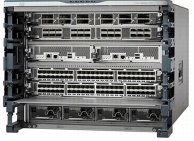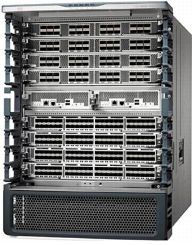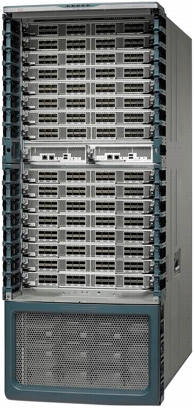|
|
Product Overview
The Cisco Nexus® 7700 Switches is the latest extension to the modular Cisco Nexus 7000 Series Switches. Capable of 83 terabits per second (Tbps) of overall switching capacity, the Cisco Nexus 7700 switches deliver the highest-capacity 10, 40, and 100 Gigabit Ethernet ports in the industry: up to 768 wire-rate 10-Gbps ports, 384 40-Gbps ports, and 192 100-Gbps ports. The Cisco Nexus 7700 switches have operation and feature consistency with the existing Cisco Nexus 7000 Series Switches, using the same system architecture, application-specific integrated circuit (ASIC) technology, and proven Cisco® NX-OS Software versions.
Designed to meet the requirements of the most mission-critical data centers, these switches deliver outstanding availability and scalability and a comprehensive Cisco NX-OS feature set that includes real-time system upgrades with exceptional manageability and serviceability.
The Cisco Nexus 7700 chassis (Figures 1, 2, and 3) incorporate significant enhancements in design, power, airflow, cooling, and cabling. All three chassis have true front-to-back airflow, making them excellent solutions for hot-aisle and cold-aisle deployments. The power supplies, I/O modules, and supervisor modules are accessible from the front of the chassis, and the fabric modules and fan trays are accessible from the back of the chassis. In addition, the Cisco Nexus 7000 Series has many power saving enhancements such as temperature sensors, variable-speed fans, and high-efficiency power supplies that reduce the total cost of ownership (TCO) for customers.
Figure 1. Cisco Nexus 7700 6-Slot Switch Chassis

Figure 2. Cisco Nexus 7700 10-Slot Switch Chassis

Figure 3. Cisco Nexus 7700 18-Slot Switch Chassis

Physical Specifications
The Cisco Nexus 7700 6-Slot Switch chassis has two supervisor slots, four I/O module slots, dual-side integrated cable management, four power supply bays, and an optional front door with an air filter on the front of the chassis. On the back, it has three system fan trays and six fabric slots behind the fan trays.
The Cisco Nexus 7700 10-Slot Switch chassis has two supervisor slots, eight I/O module slots, dual-side integrated cable management, eight power supply bays, and an optional front door with an air filter on the front of the chassis. On the back, it has three system fan trays and six fabric slots behind the fan trays.
The Cisco Nexus 7700 18-Slot Switch chassis has two supervisor module slots, sixteen I/O module slots, dual-side integrated cable management, sixteen power supply bays, and an optional dual-hinged protective front door with an air filter at the front of the chassis. On the back are three system fan trays and six fabric module slots behind the fan trays.
Table 1 summarizes the physical features of the chassis.
Table 1. Physical Specifications
Power
The Cisco Nexus 7700 6-Slot chassis has four power supply bays, the Cisco Nexus 7700 10-Slot chassis has eight power supply bays, and the Cisco Nexus 7700 18-Slot chassis has sixteen power supply bays that can hold 3.0-kilowatt (kW) AC or DC power supplies. The smaller power supply configuration provides more flexibility and more detailed control in power provisioning. The four power supply bays, eight power supply bays, and sixteen power supply bays for the 6-slot, 10-slot, and 18-slot chassis respectively are designed for future growth. Each 3000-watt (W) power supply has one universal (100 to 240 volt [V]) input that can be connected to one AC source using an AC power cord with a C19 connector. Two versions are available: one for International markets, with an IEC 60309 AC plug; and one for U.S. markets, with a NEMA L6-30 AC plug.
Table 2 shows the power output provided by one Cisco Nexus 7700 3.0-kW AC Power Supply Module.
Table 2. AC Power Supply Output
Table 3 shows the power output provided by one Cisco Nexus 7700 3.0-kW DC Power Supply Module.
Table 3. DC Power Supply Output
Cisco Nexus 7700 power supplies are more than 90 percent efficient, so less power is dissipated as heat, and more power is available for the system to use than with typical power supplies. The high-efficiency 3-kW power supplies allow smaller power configuration and provide flexible power provisioning. The Cisco Nexus 7700 systems can operate in four user-configurable power redundancy modes, listed in Table 4. The power redundancy modes are designed to determine the optimum power for the combination of power supplies installed, helping ensure system availability.
Table 4. Power Redundancy Modes
The Cisco NX-OS software requires a minimum of 1730W to run the 6-slot system (three fan trays, six fabric modules, and two supervisor modules), a minimum of 3230W to run the 10-slot system (three fan trays, six fabric modules, and two supervisor modules), and 5030W to run the 18-slot system (three fan trays, six fabric modules, and two supervisor modules). If the power available from the power supplies is more than the minimum, the additional power is used to activate the I/O modules. If there is not enough power to activate the I/O modules, the I/O modules are kept in a power-denied state. After more power is provisioned, the user must turn on power to the I/O modules manually to activate them.
Under typical operating conditions, the system consumes significantly less power than the maximum values. The Cisco NX-OS software uses the maximum values to reserve sufficient power for the I/O modules. The maximum power values are determined under the worst-case conditions. The typical power rating is the value that is commonly seen in a typical facility environment. Both the maximum and typical power ratings for the Cisco Nexus 7700 system and modules can be found using the Cisco Power Calculator (CPC) Tool at: http://tools.cisco.com/cpc/DS.cpc.
Climatic Environment
Table 5 summarizes the climatic environment for the Cisco Nexus 7700 6-Slot, 10-Slot, and 18-Slot chassis.
Table 5. Climatic Environment
Airflow and Cooling
The cooling system for the 6-slot, 10-slot, and 18-slot consists of three redundant system fan trays that deliver cooling for the I/O and supervisor modules as well as the fabric modules. Each system fan tray is composed of multiple independent fans. The fan trays are removable from the rear of the chassis, allowing continuous system operation during maintenance. Each fan module incoporates fan redundancy and fan controller redundancy to deliver resilience for either a fan or controller failure. Table 6 summarizes the airflow and cooling features of the Cisco Nexus 7700 chassis.
Table 6. Cisco Nexus 7700 Chassis Airflow and Cooling Features
Cabling and Cabinet
The cable management system for the Cisco Nexus 7700 6-Slot, 10-Slot, and 18-Slot chassis is located on both sides of the chassis aligned with the module slots.
The Cisco Nexus 7700 6-Slot, 10-Slot, and 18-Slot chassis should be installed in either a standard four-post rack or a four-post cabinet that meets the depth, total equipment weight, and network cabling requirements. In addition, the Cisco Nexus 7700 6-Slot chassis can be installed in a standard two-post rack as well.
Regulatory Compliance
The Cisco Nexus 7700 6-Slot, 10-Slot, and 18-Slot chassis are designed to meet regulator emissions and immunity requirements when tested with existing and future cards and power supplies, as summarized in Table 7.
Table 7. Emissions and Immunity Specifications
Table 8 summarizes NEBS compliance.
Table 8. NEBS Specifications
The Cisco Nexus 7700 switches are designed to meet regulator safety requirements when tested with existing and future cards and power supplies, as summarized in Table 9.
Table 9. Safety Specifications
Service and Support
Cisco offers a wide range of services to help accelerate your success in deploying and optimizing the Cisco Nexus 7700 switches in your data center. Our innovative services are delivered through a unique combination of people, processes, tools, and partners and are focused on helping you increase operating efficiency and improve your data center network. Cisco Advanced Services uses an architecture-led approach to help you align your data center infrastructure with your business goals and provide long-term value. Cisco SMARTnet® Service helps you resolve mission-critical problems with direct access at any time to Cisco network experts and award-winning resources. With this service, you can take advantage of the Cisco Smart Call Home service capability, which offers proactive diagnostics and real-time alerts for your Cisco Nexus 7700 switches. Spanning the entire network lifecycle, Cisco Services helps increase investment protection, optimize network operations, provide migration support, and strengthen your IT expertise. For more information about Cisco Data Center Services, visit http://www.cisco.com/go/dcservices.
For More Information
For more information about the Cisco Nexus 7700 switches, visit the product homepage at http://www.cisco.com/go/nexus7000 or contact your local account representative.